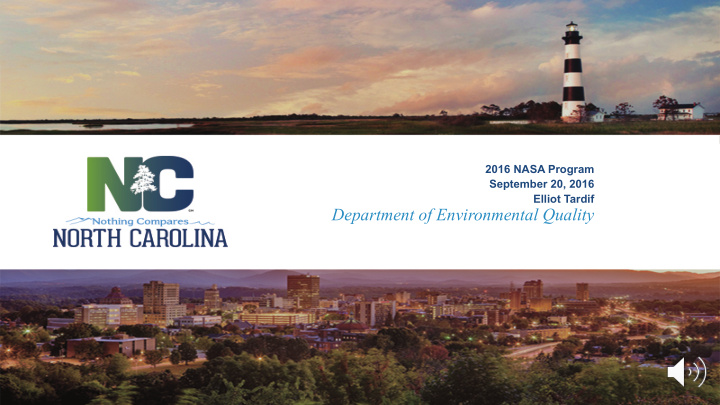



2016 NASA Program September 20, 2016 Elliot Tardif Department of Environmental Quality
Presentation Outline • PAST • Clean Air Act Amendments, State Rules, Court Cases and the evolution of North Carolina Air Quality. • PRESENT • Electric Generating Unit shutdowns, Attainment of Air Quality Standards and State Rule Streamlining • FUTURE • Pollution transport to other states, Clean Power Plan, Tier 3 engine and fuel standards and Regional Haze Rule compliance 2
About NC 3
4
5
6
7
Past 8
PAST • North Carolina had very polluted air into the 1990’s • State was facing many nonattainment areas for both ozone and fine particulate matter (PM2.5) • Growing concern over impacts of pollution on the mountains • Two North Carolina counties with highest toxic releases in the country. 9
PAST • State and Federal measures implemented to reduce pollution. • U.S. Environmental Protection Agency enacted the NOx SIP Call in 1998. • First effort to reduce point-source NOx on a regional scale. From: https://archive.epa.gov/ttn/ozone/web/pdf/otagfs.pdf 10
PAST • State and Federal measures implemented to reduce pollution. • State of NC changed & expanded vehicle Inspection and Maintenance program. • From idle tailpipe test to On Board Diagnostic program. • From 9 counties to 48 counties. • Phased in spatially from 2002 to 2006. 11
PAST • State and Federal measures implemented to reduce pollution. • State of NC implemented the Clean Smokestacks Act in 2002. • Set a statewide cap of NOx and SO2 emissions from coal-fired Electric Generating Units (EGUs). • Reduce NOx emissions from 245,000 tpy in 1998 to: 60,000 tpy by 2007 (76% reduction), 56,000 tpy by 2009 (78% reduction). • Reduce SO2 emissions from 489,000 tpy in 1998 to: 250,000 tpy by 2009 (49% reduction), 130,000 tpy by 2013 (74% reduction). 12
PAST • State and Federal measures implemented to reduce pollution. • North Carolina sued Tennessee Valley Authority (TVA) in 2006. • Ozone & ozone precursor transport from TVA facilities constitute a “public nuisance.” • TVA, EPA and NC settled suit via consent decree in 2011. • Reduce NOx emissions by over 50,000 tpy by 2018. • Reduce SO2 emissions by 175,000 tpy by 2018. http://www.npr.org/templates/story/story.php?storyId=6417740 13
Present 14
PRESENT • North Carolina currently attains all NAAQS for the first time in over 20 years. 15
PRESENT • Better-than-expected NOx and SO2 reductions resulting from the Clean Smokestacks Act 16
PRESENT • Better-than-expected NOx and SO2 reductions resulting from the Clean Smokestacks Act • Many electric facilities converting from coal to natural gas. • Older, inefficient coal plants shut down. Jan. 2014 17
PRESENT • Semi-anticipated CSA consequences • Compliance with new federal Mercury Air Toxics Rule. • Compliance with Ozone Transport Rule (CSAPR). • Compliance with Regional Haze rule. • Mountain sites well ahead of Jan. 2014 targets. • Lower cost and longer time window for utilities to implement under CSA than under federal rules. • Reduction in carbon dioxide emissions. • Public health benefits documented in peer-reviewed journal papers. 18
PRESENT • Streamlining state rules • Redundant to federal rules. • Don’t achieve intended environmental benefit. • Needlessly cost money. • Gasoline Reid Vapor Pressure (RVP) rules • Rule was initially enacted to reduce VOC emissions, NOx reductions negligible. • EPA approved NC’s proposal to remove RVP rules in greater Winston-Salem, Raleigh, then Charlotte areas. • Uniform fuel standards statewide, saves NC motorists millions of dollars per year. http://www.wral.com/nc-denr-triangle-triad-motorists-saved-about-18m-in-gas-costs-this-summer/14034049/ 19
Future 20
FUTURE • Federal Tier 3 fuel and engine standards for vehicles to be enacted nationwide in 2017. • Reduce light-duty vehicle tailpipe emissions standards by 80% compared to existing Tier 2 fuel and engine standards. • Reduce SO2 emissions by 56% starting in 2017. • Reduce mobile NOx emissions by 10% by 2018, 25% by 2030. https://www3.epa.gov/otaq/images/tier3.pdf 21
FUTURE • Clean Power Plan • Proposed by the Obama Administration in 2015 • Reduce CO2 emissions nationwide. • State-specific CO2 emissions targets by 2030. • Promptly litigated by 27 states and private industry groups. • North Carolina concerned that the Clean Power Plan does not account for CO2 emissions reductions already enacted under the CSA. https://www.epa.gov/sites/production/files/2015-08/documents/fs-cpp-overview.pdf 22
FUTURE • Updated Ozone Transport Rule • Current Ozone Transport Rule based on the 2008 8-hour ozone NAAQS. • Future year: 2017. • Future Ozone Transport Rule will be based on the 2015 8-hour ozone NAAQS. • Future year: 2023. • NC received appropriate outcome in latest modeling results. • Concerns remain with some technical details of the modeling analysis. https://www.epa.gov/airmarkets/final-cross-state-air-pollution-rule-update-benefits-information-and-maps 23
FUTURE • Regional Haze Rule • Next 10-year planning cycle coming up • 2018-2028. • North Carolina’s mountain sites are well ahead of visibility targets for 2028. • Swanquarter National Wildlife Refuge, on North Carolina’s coast, is ahead of 2018 visibility targets but not yet ahead of 2028. • Where do the emissions reductions come from? https://www.epa.gov/airmarkets/final-cross-state-air-pollution-rule-update-benefits-information-and-maps 24
QUESTIONS? Elliot Tardif, Meteorologist Division of Air Quality 919-707-8483 elliot.tardif@ncdenr.gov http://deq.nc.gov/about/divisions/air-quality Department of Environmental Quality 25
Recommend
More recommend